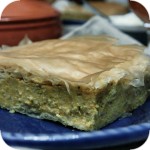

I have never had a good opinion about stuffed vegetables. I always associated them with a bland and not very tasty dish. Until I came across a Greek way to prepare stuffing. The proportions and its ingredients are excellent, so stuffed peppers for good has settled on our table. The Greeks have once again proved that they know how fantastic vegetables can be made.
The dish needs a large number of ingredients, but their compilation tastes great, so you should not eliminate any. In case you get some stuffing, you can use it to stuff tomatoes. It will also be good, although the pepper works better due to the specific, distinctive taste. As in the case of other dishes in which feta occurs, do not use its Polish or German substitutes, because these cheeses taste completely different than the original Greek feta, which combined with a large amount of herbs clearly enliven the taste of the dish.
1. We start with the preparation of peppers. Cut them along without cutting off the stalks and remove the seed seats. Halves of the peppers should be placed quite tightly in a casserole with the cut side up.
2. Peanuts should be put on a small pan and irrigated with stirring once in a while, so that they do not burn. The nuts must clearly turn brown and become crunchy.
3. On a large pan, warm up 2-3 tablespoons of olive oil and throw chopped onion and garlic, which fry until softened, making sure that they do not start to brown. Then pour the rice into the pan, chopped chili peppers, season with oregano, salt and pepper. Mix everything, pour half of the prepared portion of broth and cook for about 8-10 minutes, systematically stirring so that the rice does not start sticking to the bottom. After this time, the stuffing pan should be removed from the heat and add the rest of ingredients: crumbled feta, browned pine nuts and chopped herbs. All ingredients must be mixed thoroughly.
4. Fill the halves of the peppers to the brim with prepared filling. Do not apply more stuffing, because rice will still increase its volume. If we get some stuffing, we can fill it with tomatoes. In tomatoes, cut off the upper part and delicately using a teaspoon, hollow them from the pulp.
5. After applying the filling, pour the halves of peppers and tomatoes with olive oil. This can not be omitted because the stuffing after baking will be too dry. Tomatoes are covered with cut tops.
6. In a separate container for the remaining vegetable broth, add a tablespoon of tomato puree, mix thoroughly and pour into the bottom of a casserole, in which the peppers and / or tomatoes lie.
7. The dish must be tightly covered with aluminum foil and then placed in the oven preheated to 200 ° C for 75 minutes. After baking, we serve hot vegetables preferably accompanied by a glass of white wine.


Recently, we served a recipe for a spicy pumpkin pie baked in a sweet version. This, of course, is not the only way to prepare this universal vegetable. Greeks often also prepare a pumpkin roasted in filo, but with the addition of cheeses, on the salty.

Omelettes in Greece are prepared with the addition of various types of vegetables. However, we would like to offer you a somewhat original recipe referring to the Greek omelettes, in which the main additions are asparagus, spring onion and feta.

Briam is one of the most popular vegetable dishes in Greece. It is a classic casserole in which potatoes, eggplant, zucchini and onions seasoned with herbs and olive oil permeate each other with their flavors and aromas.
Komentarze
faszerowane pomidory
Najpyszniejsze faszerowane pomidory jadłam w tawernie przy elafonisi, byly po prostu doskonale przyprawione i połączone z ziołami, mega aromatyczne, gdzie indziej nie były już takie dobre.
Wypełnij poniższy formularz aby dodać komentarz